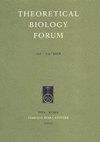共生物种的基本微观模型
IF 1.2
4区 生物学
Q4 BIOLOGY
引用次数: 0
摘要
本文以达尔文雀为例,介绍了一种基于微观主体的模型来研究同一生态位中资源竞争导致的同域物种形成。个体间竞争和资源分配的变化,使该模型表现出进化分支过程的一些主要特征。该模型可以扩展到空间效应、不同基因位点、有性交配和重组等方面,非常适合于进化论的教学。本文章由计算机程序翻译,如有差异,请以英文原文为准。
An Elementary Microscopic Model of Sympatric Speciation.
Using as a narrative theme the example of Darwin's finches, a microscopic agent-based model is introduces to study sympatric speciation as a result of competition for resources in the same ecological niche. Varying competition among individuals and resources distribution, the model exhibits some of the main features of evolutionary branching processes. The model can be extended to include spatial effects, different genetic loci, sexual mating and recombination, etc. and is well-suited for teaching the theory of evolution.
求助全文
通过发布文献求助,成功后即可免费获取论文全文。
去求助
来源期刊

Theoretical Biology Forum
Agricultural and Biological Sciences-General Agricultural and Biological Sciences
CiteScore
1.10
自引率
0.00%
发文量
0
 求助内容:
求助内容: 应助结果提醒方式:
应助结果提醒方式:


